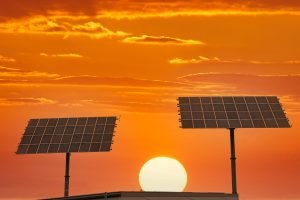Global warming is one of the world’s greatest problems in the 21st century. The deteriorating situation is not helped by electricity production, for example, as it is often not really eco-friendly and produces large amounts of greenhouse gases. However, we have a clean source of energy at our fingertips, one with the near infinite potential to cover our energy needs

The largest nuclear reactor known
The Sun, because we are talking about the largest thermonuclear reactor we know. Although it is rarely viewed in this way, it uses a form of nuclear fusion, which in a very simplified way means it can be considered an enormous fusion power plant. The problem is in how to connect to this great power plant. In this case we are helped with one product of the Sun – light. By suitable processing it can provide us with clean electricity.
Half a century from invention to popularization
The light generated by the Sun can be processed into electricity by using solar cells. These transform the sunlight into electricity thanks to the photovoltaic effect. The cells are typically constructed of silicon, germanium or selenium. They have become popular only fairly recently, since the year 2000. Although they have been known for some time (since the 1950s), their large-scale application was not uneconomical due to high production costs. Thanks to the considerable reductions made in production costs, solar panels can be found not only in large solar power plants or on the roofs of large buildings, but increasingly commonly on single family homes or blocks of flats.
Growing popularity
The data increasingly indicate that solar cells will become the most common source of green energy in the near future. Due to its growing accessibility and drops in solar cell prices, linked to the appearance of new manufacturers on the market, cities are also increasingly turning to solar cells as RES. Thanks to their diverse sizes, they can supply such small items as single lanterns as well as large buildings. It is believed that solar cells will largely bring many places closer to achieving their plans for 100% use of renewable energy sources. Such places include California, which has an established objective of obtaining all of the energy it uses from sustainable sources by 2045.
Solar cells in Poland
A sudden increase in the number of cells installed has also been observed in Poland. This derives partly from the government programme, “My electricity”, which has the aim of popularizing solar cell microsystem use in Poland. The developers of newly constructed investments also take into consideration the installation of solar panels. The number of companies in this industry is also increasing thanks to the growing interest in the panels. The PCC Group offers silicon metal and silica dust, addressed to companies producing modern photovoltaic cell and other products.
References:
https://www.npr.org/2018/09/10/646373423/california-sets-goal-of-100-percent-renewable-electric-power-by-2045?t=1536633415379&t=1536829763095&t=1607067299762
https://mojprad.gov.pl/
https://krainaoze.pl/historia-i-fenomen-fotowoltaiki/